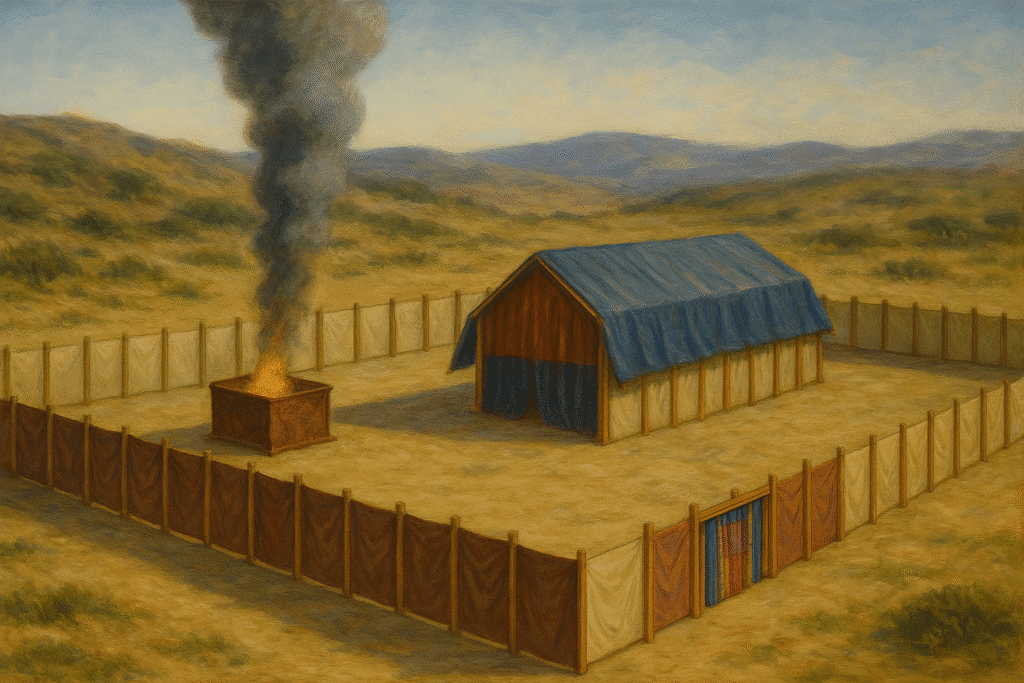Introduction: Instructions for the Tabernacle
Exodus 25–31 contains God’s detailed instructions for the tabernacle and the priesthood for Israel. This sacred plan would establish a place where God’s presence would dwell among His people, and where worship, sacrifices, and priestly service would take place according to His holiness. Every measurement, material, and design element carried symbolic meaning, pointing forward to Christ’s ultimate work of redemption.
Exodus 25 – The Ark, Table, and Lampstand
God begins with the most sacred item — the Ark of the Covenant — to be placed in the Most Holy Place. Made of acacia wood overlaid with gold, it would hold the testimony (the Ten Commandments) and be topped with the mercy seat where God’s presence would appear. God also commands the making of a table for the bread of the Presence and a gold lampstand.
Exodus 26 – The Tabernacle Structure
The instructions for the tabernacle continue with the curtains, clasps, frames, and coverings. Every detail — from the fine linen with cherubim designs to the gold-covered boards — speaks of beauty and holiness. The structure would separate the Holy Place from the Most Holy Place, emphasizing God’s holiness and the need for atonement before entering His presence.
Read full Exodus 26 account and lessons here
Exodus 27 – The Altar of Burnt Offering and Courtyard
God commands the construction of a bronze altar for sacrifices and the surrounding courtyard of the tabernacle. The altar would be the first object encountered upon entering, reminding Israel that approach to God begins with sacrifice. Instructions are also given for the oil that will keep the lamp burning continually.
Exodus 28 – Garments for the Priesthood for Israel
The priesthood for Israel is set apart with holy garments. Aaron and his sons are chosen as priests, and their garments — including the ephod, breastpiece, robe, and turban — are richly symbolic. The breastpiece holds twelve stones for the twelve tribes, showing that the priest represents all Israel before God.
Exodus 29 – Consecration of the Priests
God gives instructions for a seven-day consecration ceremony for the priests. This includes sacrifices, the anointing of Aaron and his sons, and the offering of food on the altar. The process shows that no one may serve before God without being cleansed, set apart, and covered by atoning blood.
Exodus 30 – The Altar of Incense and Other Instructions
God commands the making of the altar of incense, the collection of atonement money, the bronze basin for washing, and the anointing oil. The incense represents the prayers of God’s people rising before Him, and the washing basin reminds priests of the need for purity before service.
Exodus 31 – Skilled Craftsmen and the Sabbath
God appoints Bezalel and Oholiab, filling them with His Spirit for skill in craftsmanship. This shows that artistic and practical abilities are gifts from God for His purposes. The section closes with a reminder of the Sabbath — a sign of the covenant between God and Israel.
Conclusion: Priesthood for Israel and God’s Presence
These instructions for the tabernacle and the priesthood for Israel reveal God’s desire to dwell among His people in holiness. Every element pointed forward to Christ, our High Priest, and the ultimate dwelling of God with His people. For Israel, this was the blueprint for worship, service, and communion with God.
For a deep dive into Genesis, see the Genesis Chapter-by-Chapter Review.
Read the full text in the Book of Exodus (KJV).
